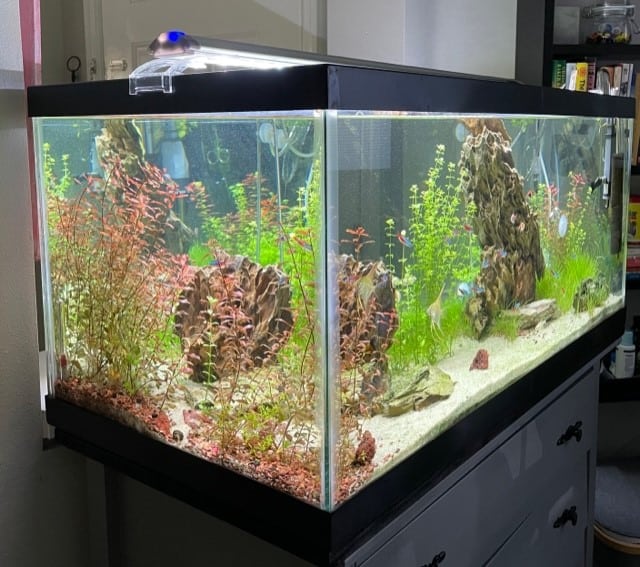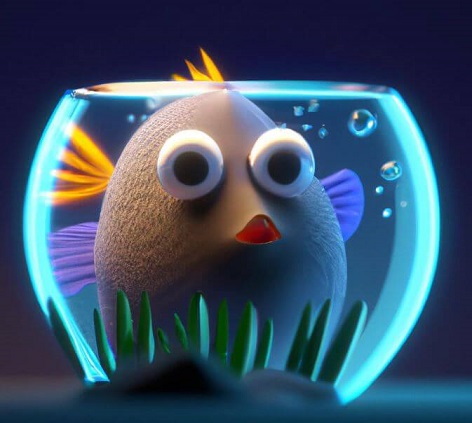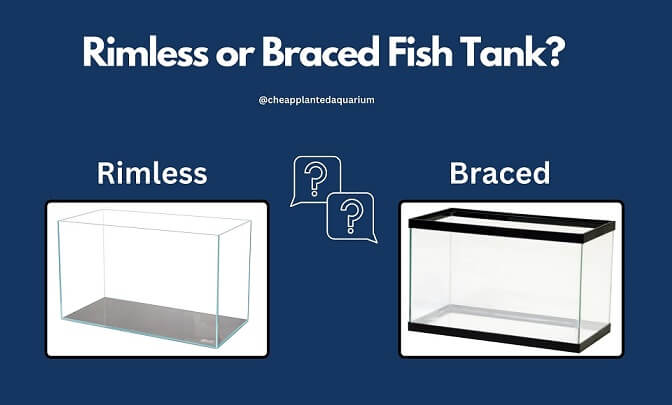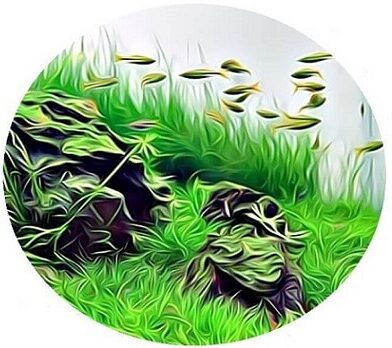Fish Tank Sizes. How to Choose the Right Fish Tank
The fish tank itself is one of the most critical components of your aquarium ecosystem.
If you make the wrong decision, you will regret it forever.
If you buy a weak water filter or a robust water heater, you can easily replace them, but the same statement is not true when you talk about the tank itself, with water on it, fish, rocks, etc.
When you start to look for a fish tank, you will find out that there are many choices, for example, different sizes, formats, material used on it, and so on. Some are made with glass, others with acrylic. Some have a metal frame, and others don’t.

In this guide, I explain fish tank sizes, types, and tank materials so you can make the most educated and precise decision possible.
Table of Content
Which Fish Tank Size Should I Choose? The Crucial Decision
Don’t think small. Go big. Thrust me! Don’t regret it later.
Although big tanks are hard to maintain, small ones are more challenging.
When the tank is small, many things go wrong very quickly, and you could have a lot of issues getting worse quicker than in a bigger tank.
For example, let’s say a fish dies, and you don’t see. It will start to decompose, and in a small tank, the water quality will get horrible very fast since you don’t have many gallons of water.
Another problem with small tanks is you can only have a few fish and you will soon get frustrated. You will most likely consider buying a bigger one.

A 10-gallon tank is a good start. It can accommodate 4 fish, 3 or 4 shrimps, and 2 or 3 snails, and you have space for plants (obviously, it depends on the fish size).
Other standard sizes are 20 gallons and 40 gallons.
What are the most common aquarium sizes?
The most common aquarium size, according to research made in 2020, is the 20-gallon tank.
Nevertheless, these are the standard sizes per type of hobbyist.
- 10 gallon: this is a common aquarium size very popular for beginners. It’s suitable for small fish species and can fit easily in most homes.
- 20 gallon: A bit larger common aquarium size. It provides more space for fish and allows for a greater variety of species.
- 29 gallon: Another intermediate common aquarium size, the 29-gallon tank is a good choice for those who want a moderately sized aquarium without committing to a large setup.
- 55 gallon: This is a larger common aquarium size that allows for a greater diversity of fish. It’s a popular choice for hobbyists who want a more substantial aquarium.
- 75 gallon: A larger tank that provides even more space for fish and allows for more elaborate aquascaping or in cases where you want to have bigger fish or monster fish.
How many fish can each fish Tank Size accommodate?
The question “how many fish in a tank?” doesn’t have a straightforward answer because the appropriate number of fish in a tank depends on various factors, including the size of the tank, the species of fish, and the specific needs of those fish.
Overcrowding a tank can lead to water quality issues, stress, aggression among fish, and other health problems. It’s important to consider the adult size of the fish, their social behavior, and any specific requirements they may have.
As a general guideline, you can use the “inch per gallon” rule, which suggests keeping 1 inch of fish for every gallon of water. However, this is a rough guideline and should be used with caution. It’s better to research the specific needs of the fish you want to keep and consider factors such as filtration, aeration, and water change frequency.
In any case, it’s crucial to research each species and tailor the stocking levels to provide a healthy and suitable environment for your fish.
How many gallons is my fish tank?
If you want to know how many gallons your fish tank has, multiply the Length x Width x Height (in inches) and divide it by 231.
You can also use this online calculator.
Fish Tank Weight Calculator
Do you need help calculating your full tank weight?
This calculator only works for freshwater aquariums.
Remember to add the weight of your substrate and decoration.
Rimless or Braced Fish Tank?
Braced fish tanks (or also called rimmed fish tank) are cheaper than Rimless tanks as they are more popular and easy to find.
Bigger tanks are always braced as the metal that involves the tank gives extra protection against the water pressure.
Rimless (or braceless) tanks are more challenging to find. There is no question that, aesthetically speaking, they are more pleasing to look at. Aquascapers looking for a pure design always use them.

Unless you plan to make a planted high-tech aquarium with CO2, special lights, and plants, I would stick with the braced tanks as they are cheaper and easier to find, and to be honest, I don’t mind braced tanks.
Glass or Acrylic fish tank? Which Fish Tank Material is Best?
You will find Glass and Acrylic tanks. I did a lot of research when looking for my newer tank, and despite the good reviews and opinions on the acrylic tanks, there is no question that most of the comments and reviews are in favor of the glass tank.
Acrylic tanks are lightweight and can be curved.
Still, glass aquariums are more scratch-resistant, have fewer fabrication flaws, and don’t distort the visual.
A common question is how long do acrylic aquariums last. And about glass aquarium?
The average lifespan for a an acrylic aquarium is somewhere between 5 and 15 years if they’re properly maintained. A glass tank is 15 to 25 years.
I recommend you this other article as your next read: Fish Tank Basics.
What is next?
As you are looking for a aquarium fish tank, I suggest you to have a look on this Water Parameters article when I explain what is pH, Ammonia, Nitrite and Nitrate. How to measure them, how to manage them and how to keep your fish healthy.
If you are looking to have a Betta Fish, check this article to learn about this amazing fish.
Finally, you will need a water filter. In this article I explain the different types of water filters.
